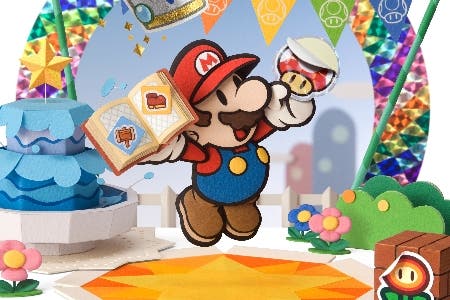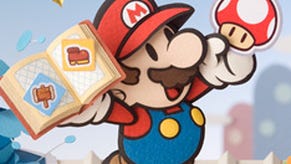Paper Mario: Sticker Star review
Slightly faded.
The thing about Mario is that, as much as he looks like a little dungareed chap, he's not really a character. Ever since Nintendo's rise in the 1980s, he's been an icon: the embodiment of pure gaming joy, a wah-hooing hero eternally saving Mushroom Kingdoms in between entering every sporting event going. It's funny to think of how many different Marios there have been - and it's this aspect of the character that Paper Mario has always riffed on.
Paper Mario is a world about Mario, one built out of in-jokes and fourth-wall-breaking nods, where the biggest gag is that everyone's been through this before. This self-mockery has always led to the finest work of Nintendo's supremely talented localisation team and Sticker Star once again delivers the goods. Matched up to Intelligent Systems' most visually brilliant take on the paper Mushroom Kingdom yet, this is one of the wittiest and most surreal Mario games in years.
Sticker Star begins predictably: the Mushroom Kingdom's various denizens are enjoying a sticker festival, when up turns Bowser and throws a spanner in the works. Peach is gone, the Toads are squooshed against the walls, and a mystery comet has been scattered to the four winds. Let's-a go!

Sticker Star's earlier worlds are used to familiarise the player with an unusual combination of styles, both mechanical and visual. First things first - Sticker Star is so good-looking that it validates owning a 3DS. The aesthetic is a straight descendant of the previous Paper Mario games but is utterly transformed by 3D and, beyond even that, its masterfully controlled camera.
The world consists of '2D' images of its paper characters, which flip over when they turn around, set on a fully 3D background. So you're looking at a 3D space filled with 2D objects that can be hiding things immediately behind them, hence the frequent use of tilted angles. The game plays with this constantly; hiding secret entrances between layers, filling the levels with objects to be hammered and hopped on and at its best, hiding solutions in plain sight.
To an extent this has always been the Paper Mario series' gimmick, but the shift into 3D brings it to stunning life - and that's just the environments. When it comes to bespoke 3D tricks, Paper Mario has several sticker albums full of them, the most instantly appealing being a weapon called the 'Slaphammer' that sends foes careening back and forth on your screen. It can do subtle, too. The snowflake effects in the obligatory ice world are simply exquisite, while the enormous amount of care that has gone into incidental details shows. Try hitting Mario's hammer on the floor repeatedly and counting how many different types of dust cloud it sends billowing out.
It's a world that's been exquisitely crafted from top to bottom, and the glue holding it together is the gum-backed stickers dotting every surface. Every Mario item you can imagine is represented in sticker form, from mushrooms and fire flowers to frog suits and boomerangs. The stickers beg to be pulled free - Mario's straining animation a masterpiece in comic exertion - and pop loose with a burst to the skies before fluttering earthwards. Every one goes in the sticker book, which is your all-purpose problem-solver.
The Wii's Paper Mario tried real-time battles, with somewhat mixed results, so Sticker Star returns to turn-based fights. It's a very streamlined system that junks almost all role-playing elements. Mario still has a health bar but he won't be levelling up or increasing his attack power; instead, everything is tied to stickers, with shiny and flashy versions of these presenting the upgrade path.
"It's simply too easy. The normal foes, beautifully presented and imaginative as they are, fall over to standard stickers."

Stickers are one use only, and for maximum damage you have to tap along to the rhythm of that particular attack as it plays out. It's an elegant approach that guarantees variety across battles, because you're always using and acquiring new stickers from whatever's around, but as a system it's very light on tactics. It's simply too easy. The normal foes, beautifully presented and imaginative as they are, fall over to standard stickers. In the absence of those more traditional RPG elements, it means there's no long-term reason for battling either, so the procession of simple victories can become a drag.
The bosses are a whole different story. Unusually for an Intelligent Systems game, the balancing feels off, with normal enemies a cakewalk and bosses a nightmare. Simply spamming the one-armed bandit, a battle feature that lets you use multiple stickers, is sometimes enough, but other monsters require specific stickers at specific points. Thanks their one-use nature, this can be frustrating. There's a battle against a giant Cheep-Cheep that requires a fishing hook sticker; after finally finding it, I returned and in my excitement used it immediately, but Cheep Cheep wasn't in the water yet. I had to run away, go and get another hook, turn that into a sticker, and then return to the battle.
The special stickers are, unfortunately, the main part of Sticker Star's poorly executed puzzle system. While exploring you'll often find 'real' items like vacuum cleaners or lightbulbs, which can then be turned into stickers. At any point, Mario's easily forgettable sidekick can 'paperise' the screen, which turns the level you're looking at into a 'flat' 2D layer with Mario floating above, ready to press stickers down. Put the right item in the right place - for example a bowling ball next to a field of skittles - and interesting things happen.
Despite the often brilliant visual pay-offs, it's a mechanic straight from point-and-click adventure games, with all the attendant faults. Only one solution is right for each problem, and the various items are sown across Paper Mario's world in all sorts of odd places. You will very often hit a paperisation problem and then spend the next hour replaying old worlds in the hope you'll find the right item.
"At one point, Birdo swings in and out of the screen while singing a little ditty about how it doesn't matter if you're a man or a woman."

It's a huge shame that such a beautifully made world is undercut by simplistic combat and trial-and-error puzzles. Whichever way you look at it, Mario's universe is a weird one, and Sticker Star's diamond-sharp script and scenarios deliver laughs by the truckload. There's the 'Hit it or Snifit!' game show, featuring whack-a-mole staffed by the work experience Snifits. There's a Goat sticker you can use to chew up paper enemies into little balls. There are Sombrero-wearing Shyguys that gee up their mates with swift guitar-playing. At one point, Birdo swings in and out of the screen while singing a little ditty about how it doesn't matter if you're a man or a woman.
There's a nod and a wink in almost everything Sticker Star does, from the Yoshi sphinx to jazzy takes on classic Mario themes. It's a world absolutely jammed with detail and hidden tricks, much of which is ingeniously concealed, and it's ultimately this that keeps you playing. Sticker Star's world is such a fabulous place, so interesting and funny and sinister, that the fact the combat isn't up to much takes a back seat. It all just washes over you in nice warm waves - until, every hour or so, some random sticker is required to solve a puzzle and you've no clue where it might be.
Sticker Star has two sides. One is a world that's a simple, vibrant joy to be in. The other is a set of systems so pared back that they waver between easy and tedious, matched up to a badly signposted set of puzzles. There's just enough adventure and charm to mitigate the latter, but that's the shame of it; Sticker Star squeaks a pass when it could, and should, be spectacular.



